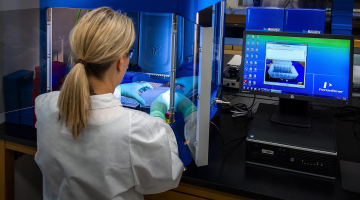

Software development process: How an idea turns into value
The time between the product being initially designed and finally released is called a software development life cycle (SDLC). Software creation is complicated. Usually, it consists of a certain number of phases. Let’s see what steps of development are responsible for, how they work, and what results they give with a guide to step-by-step software development.
How to build a software product most successfully? For one thing, it is crucial to conduct a business analysis. Professional analysts can precisely define your needs and recommend a solution that will bring value to all company stakeholders.
Our business analysts use a set of tasks and techniques that allow the development of a strategy to improve processes, incorporate significant changes, and create new policies. Based on their findings, customers get a detailed SRS document. It serves as a basis for further collaboration, legal agreement, and coherent SDLC. Let’s figure out how to develop a software project step by step.
Apply for a free consultation if you want to develop a custom solution or hire developers.
What is a software development process?
A software development process is a structured approach or methodology used by software engineering teams to plan, design, develop, test, deploy, and maintain software systems and applications. It provides a systematic framework for managing the entire lifecycle of software development (SDLC), from initial concept to final release and ongoing support.
There are various software development processes, each with its own set of principles, practices, and stages. Some common ones include Agile methodology, Waterfall model, iterative and incremental development, etc. Below, you will find detailed information on each process.
Zooming in on the advantages of a thorough development process
An entire software development process is not just a routine of building a software product. It is a way of creating a high-quality solution by breaking the work into smaller phases that can proceed either sequentially or in parallel. Its overarching goal is to obtain a high-end product quickly without compromising the quality. Such a result can be achieved by effective resource management and skillful risk minimization. In case it is implemented on a high level by a vetted team that can develop software well, the properly organized software development pipeline ushers in the following boons.
- Consistency and repeatability. Following a consistent software development roadmap, the IT team operates within a comprehensive framework, where roles, steps, and tasks are distributed between its members. It allows developers to reuse elements, employ the best practices, and rely on their past experience, which boosts productivity and minimizes negative outcomes.
- Scalability and efficiency. By exercising robust control of the development process, you can always increase the number of specialists working on the project if its scope or urgency of completion requires it. As a result, the vendor uses the resources (both human and technical) efficiently, reducing the time to market for the future product.
- Risk management. It accompanies the software development process from A to Z. The project team knows how to forestall and avoid risks and what to do if something wrong happens. By having a healthy risk management strategy in place, they can tackle possible problems early in the SDLC and make sure the project is completed on time.
- Continuous improvement. The well-established software development routine allows IT experts to review past projects and introduce meaningful changes into the pipeline. When they learn lessons and examine feedback loops, they can improve the workflow and stay competitive in a constantly evolving market.
- Quality assurance. A first-rate development process prioritizes quality. Software development professionals know that QA should be performed at every step of the procedure. When code reviews and various tests pinpoint mistakes, bugs, and security gaps before the product is finished, it takes much less effort and resources to deal with all inadequacies.
- Coordination and collaboration. Any software piece is a team product, so ensuring seamless interaction between crew members is vital. By setting robust communication channels among project managers, designers, developers, testers, and other experts with different roles and responsibilities, you will provide a constant exchange of information, avoid data siloes, and minimize misunderstandings that otherwise may arise.
You can enjoy all these benefits of an efficient SDLC when you devise a straightforward software development project plan containing manageable steps, each with its own objective and deliverables.
The core phases of software development
How to develop software most properly? In what order to go? Here are main software development steps in the project life cycle that should be followed by your development team.
Phase 1 – Brainstorming
Coming up with innovative ideas is often challenging because recent years have already brought us so many brand-new IT products and technological innovations. Because of a bunch of out-of-the-box solutions, product and project managers together with developers have to think globally to create a software application demanded in the market and, generally, offer something different.
A technique of brainstorming is effective in the IT environment. It is a creative method to find out the best solutions and ideas appropriate for implementation during the SDLC. All members of the brainstorming process contribute their ideas and offer them during the discussion. This allows everybody to feel useful and responsible for the outcomes.
This stage is also called planning as it generates the main requirements for the projects as well as creates a general roadmap. The software development project plan is one of the most important phases of software development. It influences the whole development process and the ways everything will be done.
Phase 2 – Business analysis
Before investing heavily in the project, the CEO and all team members have to carry out a feasibility analysis. The feasibility study can show how to make your own software profitable in the long run and evaluate all factors, including economic and technical, that affect the project development. Every member of the team, testers, developers, PMs, and others, must provide a clear estimate of the time they need to complete the specific tasks, efforts, and resources they need to involve. It will help calculate all expenses.
Read more about business analysis or a Discovery Phase offered by DICEUS.
Phase 3 – Selecting the tech stack and team composition
When you know what to steer by, you should come up with an exhaustive list of technologies to be leveraged in software development. Depending on the operating system (iOS, Android, or cross-platform), you should identify programming languages, tools, and frameworks the project’s implementation requires. Then, you should appoint specialists (front-end and back-end software engineers, UI/UX designers, quality assurance experts, etc.) competent in utilizing the chosen tech stack.
Phase 4 – Design
Conceptualizing the product is made during the design stage of SDLC. Design is developed according to the specifications written during the first two stages of software development. Designers, like any other architects, build the whole structure of the project and provide the final prototype that will be used for the next steps of software development.
Phase 5 – Programming
Here is coding where developers are getting started. Every programmer has his own software development tasks list for coding for which he is responsible. The software build process is controlled by project managers. This phase is the most time-consuming operation.
Phase 6 – Integration
Integrating all sources and environments is a must in figuring out how to create a software program efficiently, as it helps to figure out on time how many issues, conflicts, and bugs there are. Most teams, especially agile ones, use continuous integration. Such teams execute unit tests and use automated compilation and tests.
Phase 7 – Quality assurance
QA engineers test the quality of code written by developers. They use different frameworks and kinds of testing to learn if there are any bugs in the system. Testers write test cases and report the bugs to developers to fix them, also helping to figure out how to build a software product most efficiently.
Phase 8 – Release
The first software release will be followed by the releases of the next versions of the product. It is the final stage of development that can be also followed by maintenance and support.
Each of the stages of the SDLC life cycle depends on the model of software development a company chooses. Let’s figure out what are the main methodologies that could be used in development
5 most popular software development methodologies
A team chooses a certain set of tools and methodologies for design, testing, management, and software product development processes. These decisions depend on the goals that stand before the team and the objectives of a product to be built. Here are the most popular software development models experienced teams use.
Waterfall model
The waterfall model assumes that each stage is completed before the next one starts. For example, QA engineers start testing only after programming has been completely done.
V-shaped model
The V-shaped model is much similar to the waterfall with a slight difference – testing takes place simultaneously with the other major steps of the software development process.
Incremental model
The incremental model is divided into builds. It means that the product is built with separate blocks/parts. In other words, the product is built like a puzzle.
Rapid Application Development
Rapid Application Development is another model that IT companies use. Here, the project development is divided among small teams who work simultaneously.
Agile
Agile is a kind of incremental model where each release is focused on better software quality. This methodology is widely spread among teams and customers as it shows a continuous process and fast results. Time taken for each build can be measured here rather by weeks than by months. This is a popular model that points many entrepreneurs in the right direction of how to create a software product.
No matter what methodology your team uses the entire software development process must include all main stages: determining specifications, design, validation, and maintenance. To understand whether your development process is effective, you should apply various software development quality metrics.
Learn more about the factors affecting the software cost:
Top 10+ factors affecting software development costs
Metrics of the software development process scrutinized
In assessing the quality of the SDLC it is pivotal to avoid bias and uncertainty and arrive at objective conclusions. It can be done by leveraging the following techniques.
- Total code churn reflects the number of code lines added, altered, or deleted from the code base within a certain time span (for instance, 1,000 lines of code a week). The higher it is, the greater the probability of mistakes and bugs in the software solution, which becomes more error-prone. Also, high total code churn may indicate that the percentage of code reuse is low, which may affect the product’s performance.
- Crash rate. It is the major indicator of issues in the solution. If system crashes happen very often, it exposes the low quality of coding or substandard QA procedures applied for testing.
- Mean time between failures. It is a related index showing the average time between two system failures. The higher it is, the more reliable the solution is. In case it decreases, you should reveal the reasons for it and understand whether it is one recurrent problem or multiple issues. Or perhaps the project team’s quality of work plummeted, and they started introducing more errors than before.
- Defect density. This relative index shows the number of defects in a solution as compared to its size. The latter is determined as the quantity of code lines the product’s program has.
- System availability. It manifests the ratio of the solution’s uptime and downtime over a period of usage. Ideally, the solution should be at work 24/7.
- Mean time to detect (MTTD). It shows how long it takes the development team to spot the problem. A high MTTD is an indicator of the crew’s diagnosing efficiency, which allows it to minimize the system’s downtime during maintenance or testing.
- Mean time to resolve (MTTR). Once the problem is detected, you should fix it, and MTTR reflects the average time developers need for it. It is another pivotal efficiency clue but not as indicative as MTTD. Why? Because problems differ in severity, and more complex issues take longer to tackle.
- Mean time to remediate a vulnerability. This index has a narrower focus since it manifests the team’s performance only in fixing cyber security problems.
- Code coverage. Such a number represents the percentage of code that was covered by unit tests. It should be as close to 100% as possible since it shows that almost every bit of code underwent software quality assurance and is found bug-free and safe to use.
- Customer satisfaction (CSAT). This one may be considered the most important parameter because if users aren’t pleased with your product, other indices don’t matter. CSAT is calculated based on customer feedback given in surveys, in which people typically assess their satisfaction level on a five-point scale. Naturally, it doesn’t specify the areas of the product that underperform, so the development team must figure out the causes of low CSAT (speed of operation, roster of functionalities, cluttered user interface, subpar user experience, etc.).
Evidently, meticulous planning and efficient implementation of the software development process are no-joke tasks that should be entrusted only to vetted professionals in the realm. The qualified and certified experts of DICEUS have been present in the IT outsourcing market for over a dozen years, during which they have acquired in-depth competence in creating software products of different kinds, scopes, and complexity. If you have a software development project to implement, contact us to let our expertise bring value to your business.
Conclusion
Depending on the project needs, our team offers the best-suited methodology so that you feel comfortable collaborating with our developers. Do you have any questions concerning the phases of how to create software most efficiently or other project-related questions?
FAQ
What are the key steps in software development?
A well-organized software development process starts with the discovery phase. Then, the project team researches the niche and determines the tech stack and the roster of specialists the creation of the product will require. The development proper comprises UI/UX design and programming. When the solution is completed, it must be thoroughly tested and deployed. Most IT companies also offer after-launch support and maintenance services.
What are the different software development methodologies?
Historically, all high-tech products were developed leveraging the waterfall model. The evolution of software-building approaches saw the appearance of V-shaped, rapid application, and incremental models. The most popular trends of contemporary SDLC are Agile methodology and DevOps, which yield fast results and high-quality deliverables.
What are some best practices in software development?
The most important thing to remember is to meticulously plan everything before the actual development begins. Besides, you should keep business and technical requirements straightforward, maintain the code easy to understand, write unit tests before the code, integrate code reviews, use application frameworks instead of creating software from scratch, and employ issue trackers for your software.
What are some common challenges in software development?
While creating software, developers should overcome such obstacles as inadequate direction and leadership, problems with accurate time and resource estimation, requirement and project scope creep, rigid deadlines, conducting out-and-out debugging and rigorous testing, and providing robust communication between team members. Among all the challenges, the choice of the right development methodology is mission-critical.
What are the common trends in software development?
To become competitive in the contemporary IT world, software development companies should stay abreast of such trends as the across-the-board advent of AI, the spike in the usage of blockchain, the spread of low-code/no-code development, the rise of progressive web apps, emphasis on cyber security, universal reliance on the cloud services, onboarding of DevOps practices, the surge of augmented and virtual reality, and the transition from monolith to microservices architecture.





